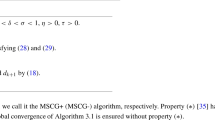Abstract
Under consideration is the steepest descent method for solving the problem of determination of a coefficient in a hyperbolic equation in integral statement. The properties of solutions to the direct and inverse problems are studied. Estimates for the objective functional and its gradient are obtained. Convergence in the mean is proved for the steepest descent method for minimizing the residual functional.
Similar content being viewed by others
References
Tikhonov A. N., “On solution of ill-posed problems and the regularization method,” Dokl. Akad. Nauk SSSR, 151, No. 3, 501–504 (1963).
Alekseev A. S., “Inverse dynamical seismic problems,” in: Some Methods and Algorithms for Interpretation of Geophysical Data [in Russian], Nauka, Moscow, 1967, pp. 9–84.
Bamberger A., Chavent G., and Lailly P., “About the stability of the inverse problem in 1–D wave equations. Application to the interpretation of seismic profiles,” Appl. Math. Optim., 5, 1–47 (1979).
Santosa F. and Symes W., An Analysis of Least-Squares Velocity Inversion. Vol. 4, Soc. Exploration Geophys., Tulsa (USA) (1989).
Dmitriev V. I. and Fëdorova E. A., “On a solution of the inverse problem by the method of partial probing of a layered medium in: Bibliographical Program on Geophysics [in Russian], Moscow Univ., Moscow, 1983, pp. 11–18.
Nyambaa Sh. and Cheverda V. A., An Optimizational Method for Solving the Electroexploration Inverse Problem on Continuous Current for Vertically-Inhomogeneous Media [Preprint, No. 794], Vychisl. Tsentr Sibirsk. Otdel. Akad. Nauk SSSR, Novosibirsk (1988).
Iskakov K. T. and Kabanikhin S. I., “The solution of one-dimensional inverse problem of geoelectrics by the method of conjugate gradients,” Russian J. Theoret. Appl. Mech., 2, No. 3, 197–222 (1992).
Romanov V. G. and Kabanikhin S. I., Inverse Problems for Maxwell's Equations, VSP, Utrecht (The Netherlands) (1994).
Kabanikhin S. I., “Numerical analysis of inverse problems,” J. Inverse Ill-Posed Probl., 3, No. 4, 278–304 (1995).
Karchevsky A. L., “Properties of the misfit functional for a nonlinear one-dimensional coefficient hyperbolic inverse problem,” J. Inverse Ill-Posed Probl., 5, No. 2, 139–165 (1997).
Romanov V. G., Inverse Problems of Mathematical Physics [in Russian], Nauka, Moscow (1984).
Kabanikhin S. I. and Bakanov G. V., “The optimizational method for solving the discrete inverse problem for hyperbolic equation,” J. Inverse Ill-Posed Probl., 6, No. 4, 513–530 (1996).
Azamatov J. S. and Kabanikhin S. I., “Nonlinear operator equations. L 2-theory,” J. Inverse Ill-Posed Probl., 7, No. 6, 497–529 (1999).
Vasil' ev F. P., Numerical Methods for Solving Extremal Problems [in Russian], Nauka, Moscow (1988).
Karmanov V. G., Mathematical Programming [in Russian], Nauka, Moscow (1988).
Author information
Authors and Affiliations
Rights and permissions
About this article
Cite this article
Kabanikhin, S.I., Iskakov, K.T. Justification of the Steepest Descent Method for the Integral Statement of an Inverse Problem for a Hyperbolic Equation. Siberian Mathematical Journal 42, 478–494 (2001). https://doi.org/10.1023/A:1010471125870
Issue Date:
DOI: https://doi.org/10.1023/A:1010471125870



